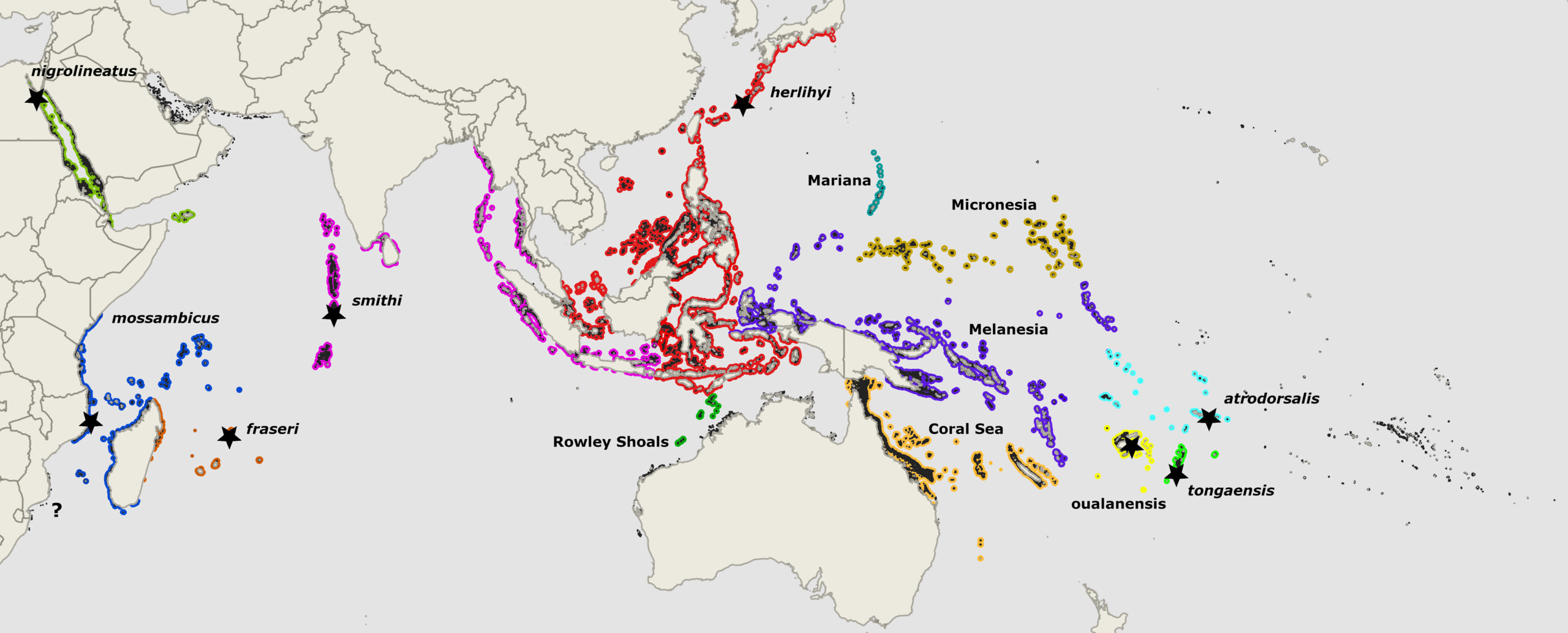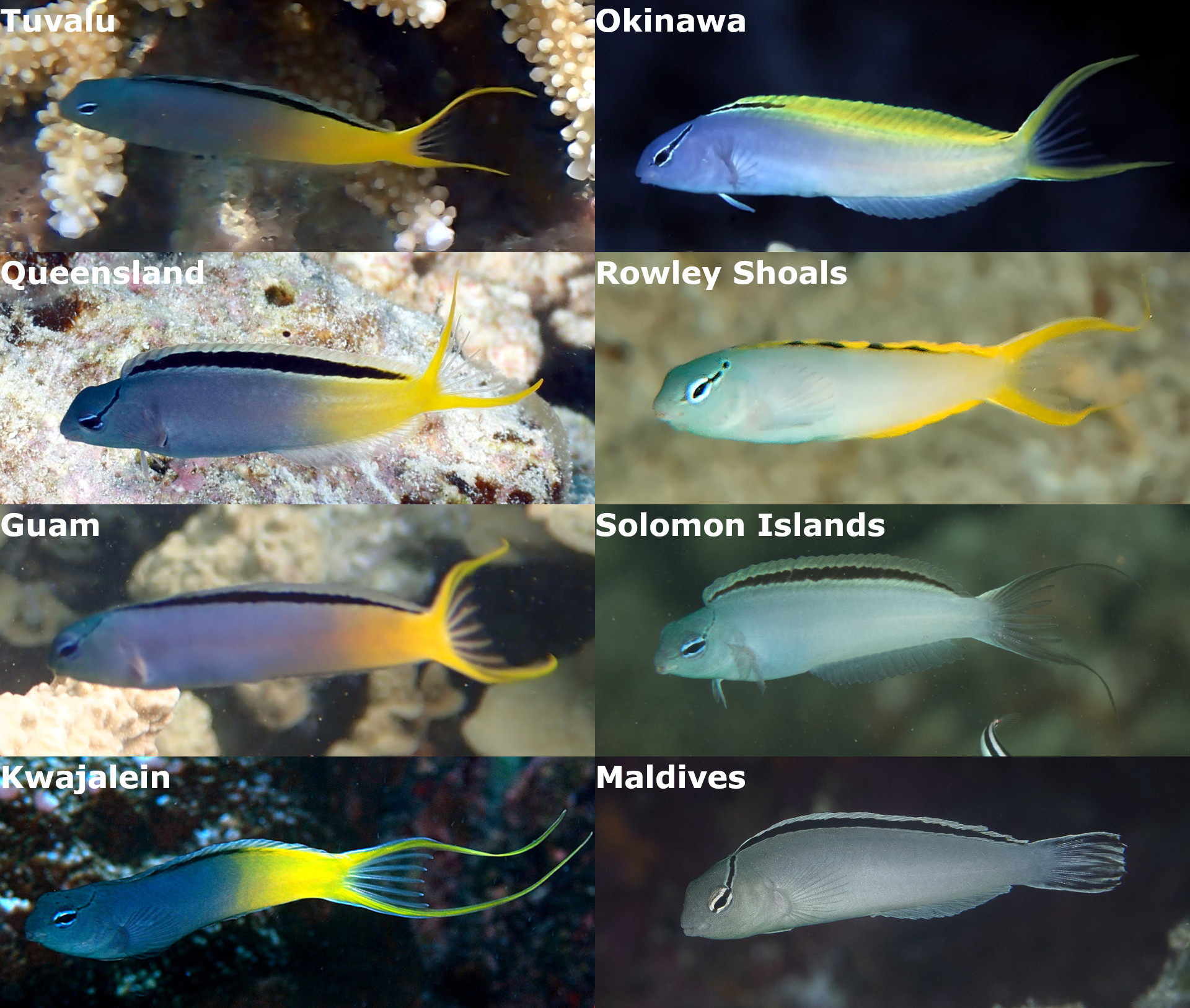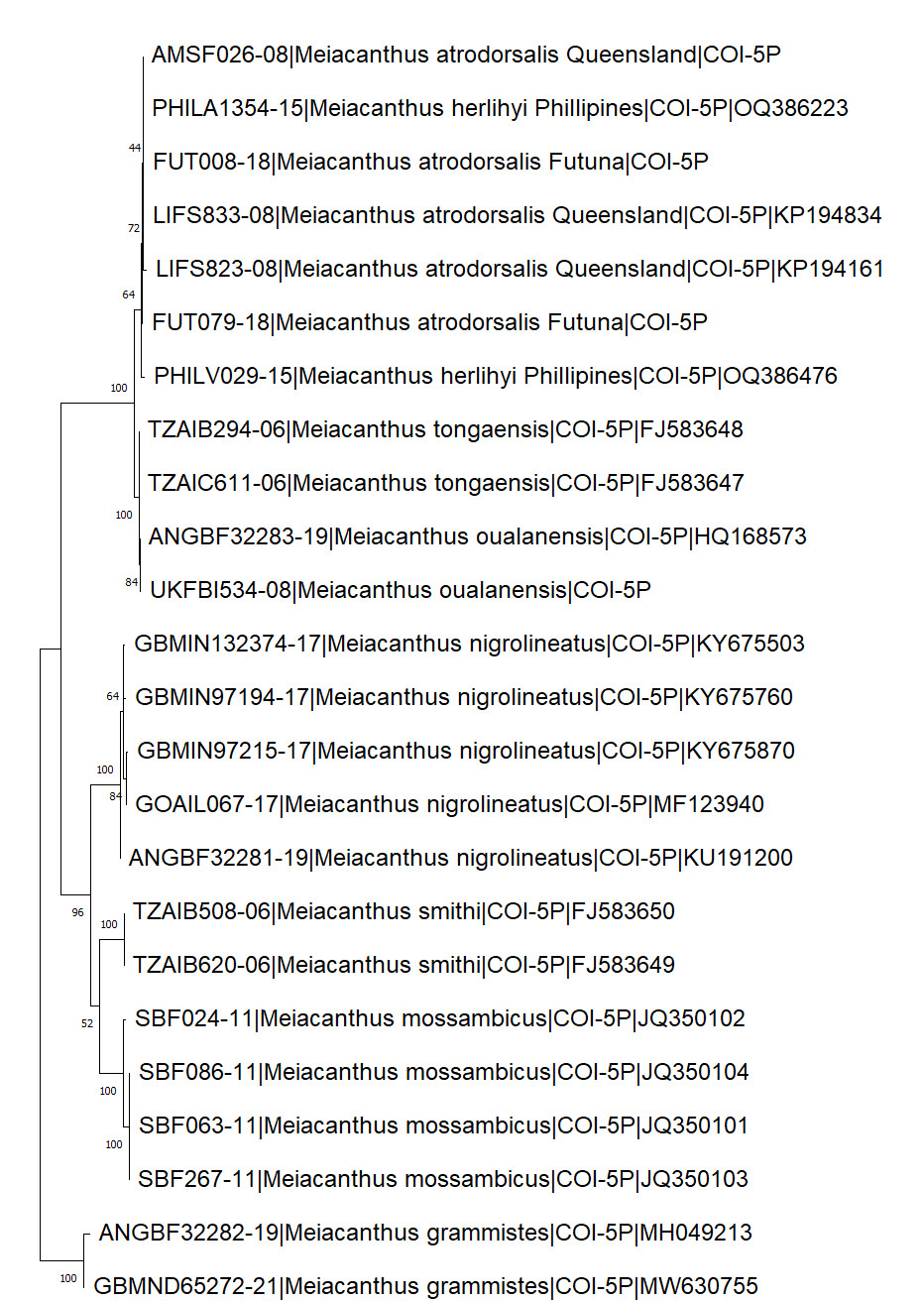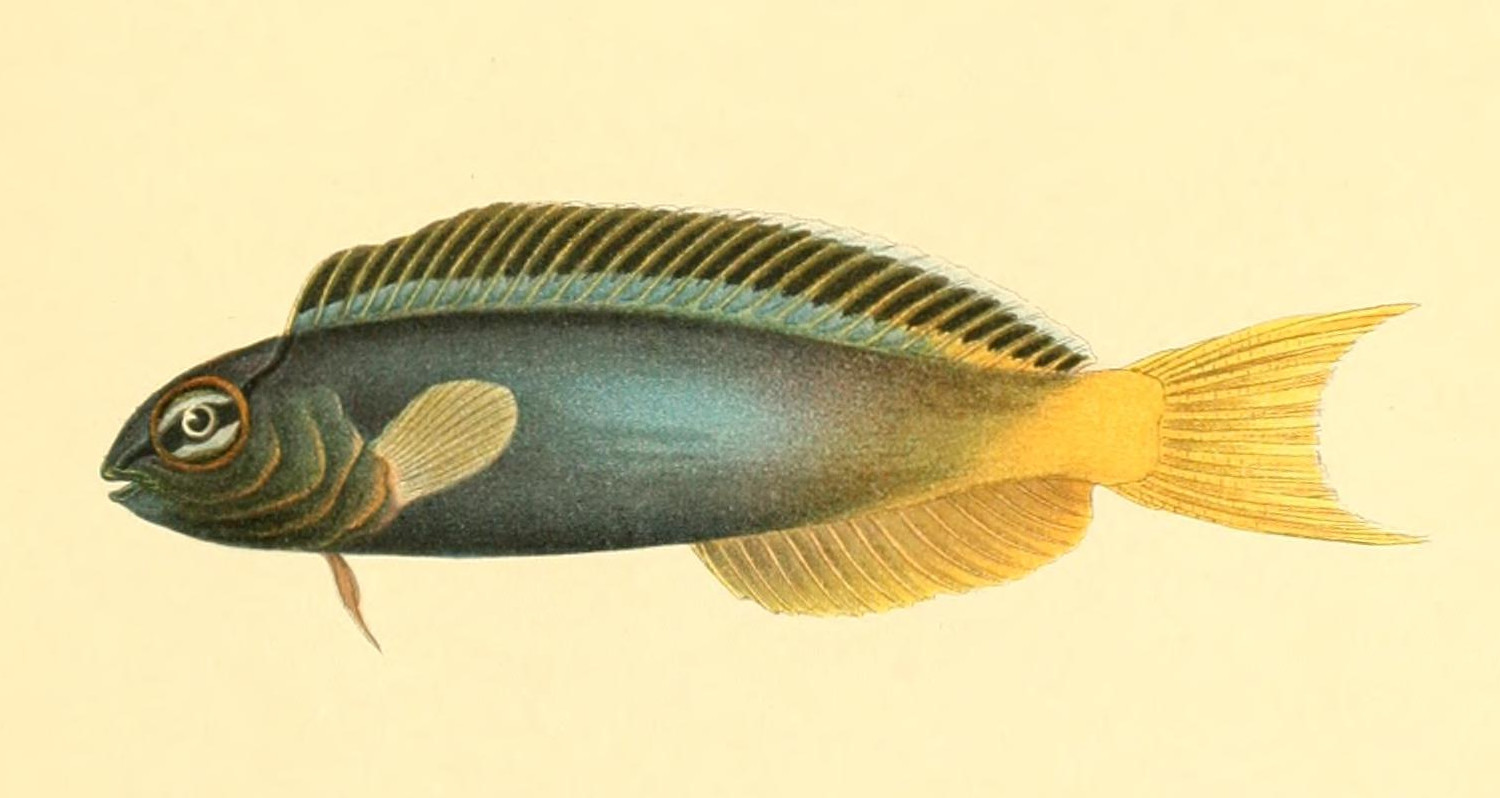Meiacanthus fangblennies are a frequently encountered group of Indo-Pacific reef fishes, several of which are regularly available within the aquarium trade, occasionally via captive breeding. The genus is home to 30 recognized species, the vast majority of which having been described by the prolific ichthyologist William Smith-Vaniz in a series of publications stretching from 1969–2019. And new species continue to be discovered, with the most recent addition being a microendemic from West Papua, M. fakfakensis, described earlier this year.
This biodiversity is mostly centered on the West Pacific and can be subdivided into 10 distinct lineages, many of which are rarely encountered, both in the wild and in captivity. However, a notable exception exists for the widespread atrodorsalis complex, comprising 8 recognized species scattered throughout the Indo-West Pacific and representing the only incursion that the genus has made into the Western Indian Ocean and Red Sea. Included amongst these are some of the most familiar aquarium species: Fiji’s vibrant yellow M. oualanensis (and its duller Tongan counterpart, M. tongaensis)… the minimalist black & white M. smithi, found from the Maldives to Bali… the colorful M. nigrolineatus from the Red Sea, famously mimicked by the harmless Mimic Blenny, Ecsenius gravieri… East Africa’s yellow-tailed M. mossambicus, a bit of an underappreciated gem, plus its dark-tailed sister species in the Mascarene Islands, M. fraseri (the only species not collected for the aquarium trade).
And rounding out the group is the ubiquitous M. atrodorsalis, a handsome species with a grayish forebody, turning bright-yellow posteriorly, and with a black streak in the dorsal fin. It’s said to occur throughout the West Pacific, from Japan to Australia and east into Micronesia. But friends, reefbuilders, we have been deceived. None other than Smith-Vaniz expounded upon it in his seminal 1989 revision of the genus: “the taxonomic status of members of the M. atrodorsalis complex is subjective and it could be argued that some or all of the five color pattern types here assigned to atrodorsalis should be recognized nomenclaturally. My decision to recognize all of these forms as one polytypic species is influenced by the fact that no two occur sympatrically, life coloration is inadequately known, and apparent differences in color patterns are relatively slight with some specimens difficult or impossible to categorize without knowledge of capture locality.”.
Smith-Vaniz, limited by a lack of fresh material and in situ photography, understandably took a conservative approach to classifying this fish and its bewildering variety of color morphs, many of which are only slightly different in seemingly minor details. Fortunately for us, the situation has improved, with a wealth of observations now readily available online, at sites like iNaturalist and GBIF. Here we can compare hundreds of specimens, picking apart the minutiae of their chromatic vestiture from nearly every reef that this fish calls home. Want to see one at a far-flung locale like Helen Reef? Bam, there ya go. How about the Gilbert Islands? Got ya covered. Or maybe you’re interested in a topotypical specimen from Samoa? This one is nearby and certainly looks quite like Günther’s figured specimen of the holotype and the colored illustration from Jordan & Seale 1906.

So let’s take these Samoan specimens as our starting point. The true atrodorsalis is so named for the thick black streak that extends the length of the dorsal fin, derived from the Greek atro– (black) and dorsalis (of the back). We also see that the body turns yellow posteriorly; this will prove to be an important detail. Moving south from here, distinct species occur at Fiji and Tonga, while heading north we see this same Samoan phenotype at Tuvalu. Continuing onwards into the poorly documented reefs of the Gilbert Islands there is a dramatic shift in color; instead of a yellow tail, we instead have a completely gray-bodied fish. And traveling northwards a bit more, into the Marshall Islands, we’re met with yet another variant, again with a yellow tail, but now with the dorsal black streak reduced in length, extending a bit past the halfway point of the fin.
This is a pattern that repeats itself throughout the West and Central Pacific. There is the true atrodorsalis, restricted to a relatively small area along the eastern edge of this broad geographical range, and then there are a handful of atrodorsalis doppelgangers, diagnosed by seemingly inconsequential variation in color and patterning (and sometimes with little, if any, phenotypic distinction). If not for the disjunct nature of their biogeography, it would be all too easy to follow Smith-Vaniz’s approach, lumping these disparate forms as mere color morphs of a single polymorphic species, but this belies the complex evolutionary history implied by their allopatry. The regions that these populations call home have been subject to cycles of genetic isolation, correlating with the rising and lowering of sea levels during the Pleistocene.

By my count, there are at least 5 undescribed species in this complex, plus one described species that has hitherto been confused as a synonym, M. herlihyi. This latter species was first collected from a shallow reef near Okinawa on July 29, 1945 by the American entomologist Ernest R. Tinkham, who at the time was serving as a captain in the US navy—this was just a week before the atomic bombing of Hiroshima. Tinkham writes, “During the darker days of our fight with the Japanese, our commanding officer, Lieutenant Colonel William J. Herlihy, played a very interesting role in helping to stop the Japanese coming across the Owen Stanley Range from Buna into Port Moresby. He was also at Buna and many other places in the fight along the northeastern shores of New Guinea. Because of his kindly interest in my efforts he deserves remembrance.” And so this is how LTC William Herlihy (1916–1997), a little-known naval officer with seemingly no direct connection to ichthyology, came to have an Indo-Pacific reef fish named in his honor. Sometimes, being in the right place at the right time gets you an eponymous fish.
Herlihy’s Fangblenny can be readily identified by having a predominantly yellow dorsal fin, with a short dark streak limited to the anterior third of the fin, as seen in this topotypical specimen and in the figured holotype from Fowler 1946 (see figure 47); also, the posterior half of the body is paler than the forebody, but usually without the contrasting shade of yellow seen in atrodorsalis. Similar specimens occur throughout the Philippines and Indonesia, save for West Papua and some nearby islands, where we instead encounter the solidly gray species that we previously saw in the Gilbert Islands. This nameless gray fish is quite broadly distributed, from Halmahera and Ceram in the west, north to Palau, south to Vanuatu, and east to the Gilbert Islands, with strays documented further still at Wakatobi and New Caledonia. No doubt hybridization must occur extensively along the edges of this range, particularly in the poorly documented waters of the Banda Sea.
Moving into the Coral Sea and Australia, we find a population that is essentially identical to the Samoan atrodorsalis color pattern, but which is biogeographically disjunct by a considerable distance. Meanwhile, on the other side of Australia, the isolated Rowley Shoals, a region well-known for producing endemic species, has unsurprisingly developed its own flavor, recognized by a bright yellow anal fin and a yellow dorsal fin with well-developed black stripe. And if we jump across Indonesia to get to the Mariana Islands, we’ll encounter yet another almost-atrodorsalis, whose colors are once again indistinguishable from those found in Samoa, half an ocean away. Lastly, in the Caroline Islands and Marshall Islands, we find a population that seems to split the difference between the robust black stripe of atrodorsalis and the abbreviated stripe of herlihyi, having a dorsal fin stripe that consistently falls somewhere in the middle, with a gray and yellow body that differs from the all-gray population to its south and west.

It’s a veritable jigsaw puzzle of nondescript Meiacanthus color morphs, the details of which are only revealed by examining many hundreds of specimens from across this vast expanse of ocean. Molecularly, only a handful of relevant specimens have been sequenced, including those representing atrodorsalis, herlihyi, and the Coral Sea population; however, these show minimal divergence in their CO1 gene (frequently used for delimiting closely related species). This on its own doesn’t mean much in the context of a rapidly speciating complex, as CO1 is prone to being noninformative for recently diverged species.
E unibus pluram. From atrodorsalis, we have revealed a half-dozen new species, most yet to be described. Interestingly enough, the true atrodorsalis has likely never found its way into the aquarium trade, with most instead coming from the Indo-Philippines and Australia.
About the author
Joe Rowlett is the author of Indo-Pacific Corals and studies marine biogeography and speciation. He is a former aquarist and has written extensively for aquarium publications.



